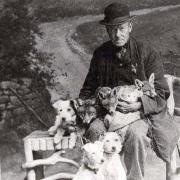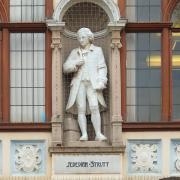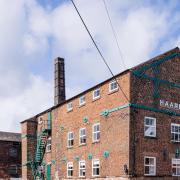Peter Seddon turns literary detective to resurrect ‘The Peak Novelist’

It is the 9th of April 1917 – Easter Monday. The horrors of the Great War continue. But Allied progress is being achieved. On that day in France the Canadian Corps began to sweep away entrenched German defences from strategic high ground above the town of Arras. But the Battle of Vimy Ridge carried a habitual cost. Even in victory 3,598 Canadian lives were lost. The vanquished Germans suffered an estimated 20,000 casualties.
Some social commentators argue that death on such a scale – and in such inhuman circumstances – ought to have tempered the impact of more natural loss of life back home, in some perverse way rendering a ‘routine passing’ more bearable. But life doesn’t work that way – witness the poignant gathering on that same Easter Monday in the north-east Derbyshire village of Holmesfield.
No shell-fire or cloying mud – just the tranquil solitude of an ancient Peak settlement and a dignified funeral at St Swithin’s church. But with no less grief – the Derbyshire Courier said: ‘The sudden passing from pneumonia of “The Peak Novelist” Mr R M Gilchrist at the age of only 50 came as a great shock to his many friends and literary acquaintances. The church was filled by villagers and intimates alike, among them the Belgian refugees billeted nearby to whom Mr Gilchrist had shown great kindness. In the churchyard the spring sunshine struggled with wintry blasts for the mastery of nature, as mourners paid heartfelt tribute to a man who was true gentleness personified.’
That lyrical passage suggests a well-liked man of literary fame – yet the grave of Robert Murray Gilchrist gives no clue to his talents. And few now recognise his name. Such are the vagaries of celebrity – in his lifetime R M Gilchrist was a noted writer, but one whose star dimmed almost to nothing after his death.

But passing years and changing attitudes can also engender renewal. Now interest in Gilchrist has revived – several of his collected works latterly reprinted. His varied oeuvre is again worth more than a cursory glance – a total of 22 novels, six short story collections, four topographical books, and a play.
Although not to all tastes – too unconventional for some – Gilchrist was praised by respected contemporaries. H G Wells admired him and ‘Potteries writer’ Arnold Bennett thought one of his short stories ‘almost the peak of perfection in that difficult genre’. Although accidental, Bennett’s word choice was punningly apposite, for Gilchrist set most of his writing in the Derbyshire Peak he knew so intimately. Cue that long-lost salutation – ‘R. M. Gilchrist this is your life’.
Robert Murray Gilchrist was born in Sheffield on 6th January 1867, one of five boys and three girls from the marriage of cousins Robert Murray Gilchrist and Isabella Murray. Educated at Sheffield Grammar School and later privately, he spent boyhood holidays in the Baslow area, an early taste of the Derbyshire countryside he would settle in. On leaving education he became a cutler’s apprentice, but found his ‘refined tastes’ not suited to industry. By the age of 21 he had left the job intent on pursuing the more Bohemian life of a writer.
He is thought to have enjoyed a brief sojourn in Paris, and visited London on isolated occasions, but generally shunned the big cities favoured by ‘literary types’. Instead he chose the quiet life in then ‘unfashionable’ Derbyshire.
He took a house called ‘Highcliffe Nook’ overlooking the famous ‘Plague Village’ Eyam – a locality steeped in myth and folklore, and close to the wild moors, it provided perfect inspiration for Gilchrist’s tales of romance and horror in the Decadent-Gothic tradition so popular in the Victorian and Edwardian eras.
On frequent long walks he absorbed the Derbyshire landscapes and distinctive ways of its people – ideas flowed, and the Peak Country with its combination of wealthy landowners and earthily-quaint rural communities became the setting for most of his work.
When aged only 23 his first novel Passion and Plaything (1890) was published to mixed reviews. Some praised its ‘hauntingly beautiful prose’ but the Spectator voiced reservations: ‘It is an almost delirious story of passion which in ordinary life would end in hysteria or madness, suicide or murder. The author is not devoid of literary prowess, but altogether this is an unpleasant book containing far too much in the way of sensuous description.’
Therein lay a clue to why Gilchrist divided opinion – he introduced themes considered controversial and even taboo by much of Victorian society. Gender lines were blurred, traditional roles of hero and heroine reversed, and the rising feminist cause ardently espoused. One of his characters was almost shockingly unthinkable – a female serial killer. Several stories featured same-sex desire – his short piece My Friend prompting later critics to remark: ‘Its homoerotic themes suggest Gilchrist was possibly homosexual’.
As such – although friends labelled the lifelong bachelor ‘old-fashioned’ in his aesthetic tastes and courtly manners – Gilchrist like Oscar Wilde was inherently ‘modern’ and ahead of his time. This explains his enthusiastic ‘rediscovery’ soon after the ‘liberated’ 1960s, and recent republishing of selected works suggests his themes resonate strongly in today’s society.
But that was all to come. Not yet knowing his literary fate, Gilchrist penned two more novels by 1894. Again they provoked uneven appraisals which questioned his ideal of ‘making a living’ from writing. Indeed he had already taken steps which gave him better security – in 1892 vacating his Eyam home to move in with his parents at the family residence Cartledge Hall in Holmesfield.
Dating from at least the 16th century, Cartledge had an ancient and doubtless spooky atmosphere which seeded ideas. The house was sub-divided for Robert and his sisters, and later for his close friend George Garfitt. Cartledge Hall remained home to Gilchrist for 25 years until his death – half his entire life.
There he began writing short stories for periodicals – ‘bread and butter’ income.
It was for these – over 100 in number – that he received his best acclaim: ‘He possessed the rare power of saying so very much in so very little, the true art of the short story’. Amongst others they appeared in National Observer, The Idler, Windsor Magazine and the infamously decadent journal The Yellow Book.
In 1894 some were gathered together in his first collection The Stone Dragon and Other Tragic Romances. This included ghost stories, Gothic horror and ‘weird tales’ – although initially scantly-praised, Gilchrist’s revival saw this become his most popular work. Rare first editions have sold for upwards of £2,000.
Another collection – published posthumously – has particular Derbyshire interest. A Peakland Faggot (1926) includes Tales of Milton folk – ‘Milton’ being Eyam – and several stories feature the broad dialect and quaint turns of expression of the ‘country Derbyshire’ once widely spoken. At times this imparts wry humour – here the ample Miss Brimble bemoans the heat: ‘By ‘r leddy et’s more nor ‘ot – et’s griddlin. I reckon I suffer more wi’ bein’ fat. I were nineteen inch raand th’waist as a gerl – an naa I’m forty and five!’
Of more topographical interest is Gilchrist’s foray into ‘travel-book’ territory with The Peak District (1911), but this was a mere sideshow – his mainstream output remained novels and short stories.
R M Gilchrist wrote to the end, and might have produced much more. But he died suddenly on 4th April 1917 just three months after his father. Writing had not made him especially wealthy – his estate £1,156 – but he left rich memories.
The Derbyshire Daily Telegraph observed: ‘He was the most gifted delineator of North Derbyshire scenery and characters that literature has given us, and one of the most charming personalities with whom anyone could desire to obtain friendship or acquaintance. He loved old friends, old books, old music, and old courtesies.
‘Always moderate of habit – the only writer to regularly contribute to the Absteiner’s Advocate the journal of the Temperance Movement – he was a big handsome presence with a stately grace, who had the same word of welcome for both rich and poor. Dazzlingly eccentric and something of a country dandy, he favoured brightly-coloured clothes, and periodically turned up in church wearing a cassock and girdle. We shall remember him as a man of quiet charm, a soft-spoken companion among his pipes and books.’
But is he a good read? Literature is a matter of taste, but the Derbyshire Times suggests he may strike a chord with us all: ‘He portrays the “slumbering fires” of spinsterhood and the thwarted desires of uncouth bachelordom with a knowing eye. He has compassion for the proud poor, and knows the hatred of old folk for accepting charity, and their suspicion of new-fangled town gentilities. And in the middle-aged he recognises those for whom sentiment has long been sacrificed in the dumb round of tedious routine.’
Almost a century has passed since that was written... some things never change!



























